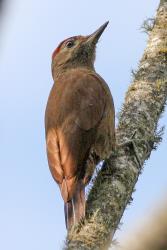The smoky-brown woodpecker or brown woodpecker (Leuconotopicus fumigatus) is a species of bird in the family Picidae.
It is found in Argentina, Belize, Bolivia, Colombia, Costa Rica, Ecuador, El Salvador, Guatemala, Honduras, Mexico, Nicaragua, Panama, Peru, and Venezuela.
Taxonomy and systematics
The species was first described by the French naturalist Alcide d'Orbigny, based on individuals observed in the Province of Corrientes in Argentina, and later in Santa Cruz de la Sierra in Bolivia.
The genus name leuconotopicus derives from the Ancient Greek leukos (white), noton (back) and pikos (woodpecker). The species epithet fumigatus is Latin for smoked.
Five subspecies are recognized:
Habitat
Its natural habitats are subtropical or tropical moist lowland forest, subtropical or tropical moist montane forest, and heavily degraded former forest.
Description
Adult woodpeckers are 15–17 cm (5.9–6.7 in) in height and weigh about 31–50 g (1.1–1.8 oz). They are characteristically dark brown. The adult male has gray, red-tipped nape feathers and tawny scapular feathers. The adult female has brown-tipped nape feathers, and juvenile woodpeckers have noticeably duller feathers.
Behavior
The smoky-brown woodpecker seems to prefer smaller tree trunks to larger ones. Their diet favors small beetles and larvae. Leuconotopicus fumigatus often travels in pairs or in family groups, sometimes with other species. They nest from February to May, making their nest 1.5–7.6 m (4 ft 11 in – 24 ft 11 in) off the forest floor. They have a clutch size of 4 eggs.


